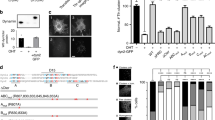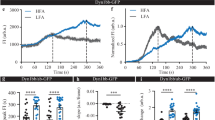Abstract
Clathrin-mediated endocytosis is a major cellular pathway for internalization of proteins and lipids and for recycling of synaptic vesicles. The GTPase dynamin plays a key role in this process, and the proline-rich domain of dynamin participates in various protein-protein interactions to ensure a proper coordination of endocytic processes. Although dynamin is not directly associated with actin, several dynamin-binding proteins can interact with actin or with proteins that regulate actin assembly, thereby coordinately regulating actin assembly and trafficking events. This article summarizes dynamin interactions with various Src homology 3-containing proteins, many of which are actin-binding proteins. It also discusses the recently identified two new dynamin binding proteins, SH3 protein interacting with Nck, 90 kDa/Wiskott-Aldrich syndrome protein interacting with SH3 protein (SPIN90/WISH) and sorting nexin 9, and outlines their potential role as a link between endocytosis and actin dynamics.
Similar content being viewed by others
References
Cousin, M. A. (2000) Synaptic vesicle endocytosis: calcium works overtime in the nerve terminal. Mol. Neurobiol. 22, 115–128.
Deitcher, D. (2002) Exocytosis, endocytosis, and development Semin. Cell Dev. Biol. 13, 71–76.
Hinshaw, J. E. (2000) Dynamin and its role in membrane fission Annu. Rev. Cell Dev. Biol. 16, 483–519.
Qualmann, B. and Kessels, M. M. (2002) Endocytosis and the cytoskeleton. Int. Rev. Cytol. 220, 93–144.
Sever, S. (2002) Dynamin and endocytosis. Curr. Opin. Cell Biol. 14, 463–467.
Damke, H., Baba, T., Warnock, D. E., and Schmid, S. L. (1994) Induction of mutant dynamin specifically blocks endocytic coated vesicle formation. J. Cell Biol. 127, 915–934.
Takei, K., Slepnev, V. I., Haucke, V. and De Camilli, P. (1999) Functional partnership between amphiphysin and dynamin in clathrin-mediated endocytosis. Nat. Cell. Biol. 1, 33–39.
Gad, H., Ringstad, N., Low, P., et al. (2000) Fission and uncoating of synaptic clathrin-coated vesicles are perturbed by disruption of interactions with the SH3 domain of endophilin. Neuron 27, 301–312.
Qualmann, B. and Kelly, R. B. (2000) Syndapin isoforms participate in receptor-mediated endocytosis and actin organization. J. Cell Biol. 148, 1047–1062.
Klein, D. E., Lee, A., Frank, D. W., Marks, M. S., and Lemmon, M. A. (1998) The pleckstrin homology domains of dynamin isoforms require oligomerization for high affinity phosphoinositide binding. J. Biol. Chem. 273, 27,725–27,733.
Lemmon, M. A. and Ferguson, K. M. (2000) Signal-dependent membrane targeting by pleckstrin homology (PH) domains. Biochem. J. 350(pt 1), 1–18.
Schafer, M. A. (2002) Coupling actin dynamics and membrane dynamics during endocytosis. Curr. Opin. Cell. Biol. 14, 76–81.
Lee, E. and De Camilli, P. (2002) Dynamin at actin tails. Proc. Natl. Acad. Sci. USA 99, 161–166.
Merrifield, C. J., Feldman, M. E., Wan, L., and Almers, W. (2002) Imaging actin and dynamin recruitment during invagination of single clathrin-coated pits. Nat. Cell. Biol. 4, 691–698.
Witke, W., Podtelejnikov, A. V., Di Nardo, A., et al. (1998). In mouse brain profilin I and profilin II associate with regulators of the endocytic pathway and actin assembly. EMBO J. 17, 967–976.
Kessels, M. M., Engqvist-Goldstein, A. E., Drubin, D. G., and Qualmann, B. (2001) Mammalian Abp1, a signal-responsive F-actin-binding protein, links the actin cytoskeleton to endocytosis via the GTPase dynamin. J. Cell. Biol. 153, 351–366.
McNiven, M. A., Kim, L., Krueger, E. W., Orth, J. D., Cao, H. and Wong, T. W. (2000) Regulated interactions between dynamin and the actin-binding protein cortactin modulate cell shape. J. Cell. Biol. 151, 187–198.
Schafer, D. A. and Schroer, T. A. (1999) Actin-related proteins. Annu. Rev. Cell. Dev. Biol. 15, 341–363.
Carlsson, L., Nystrom, L. E., Sundkvist, I., Markey, F. and Lindberg, U. (1977) Actin polymerizability is influenced by profilin, a low molecular weight protein in non-muscle cells. J. Mol. Biol. 115, 465–483.
Ochoa, G. C., Slepnev, V. I., Neff, L., et al. (2000) A functional link between dynamin and the actin cytoskeleton, at podosomes. J. Cell. Biol. 150, 377–389.
Hussain, N. K., Jenna, S., Glogauer, M., et al. (2001) Endocytic protein intersectin-1 regulates actin assembly via Cdc42 and N-WASP. Nat. Cell. Biol. 3, 927–932.
Miki, H., Miura, K., Matuoka, K., et al. (1994) Association of Ash/Grb-2 with dynamin through the Src homology 3 domain. J. Biol. Chem. 269, 5489–5492.
Benesch, S., Lommel, S., Steffen, A., et al. (2002) Phosphatidylinositol 4,5-biphosphate (PIP2)-induced vesicle movement depends on N-WASP and involves Nck, WIP, and Grb2. J. Biol. Chem. 277, 37,771–37,776.
Kessels, M. M. and Qualmann, B. (2006) Syndapin oligomers interconnect the machineries for endocytic vesicle formation and actin polymerization. J. Biol. Chem. 281, 13,285–13,299.
Wunderlich, L., Farago, A. and Buday, L. (1999) Characterization of interactions of Nck with Sos and dynamin. Cell Signal 11, 25–29.
Moreau, V., Frischknecht, F., Reckmann, I., et al. (2000) A complex of N-WASP and WIP integrates signalling cascades that lead to actin polymerization. Nat. Cell Biol. 2, 441–448.
Yoon, S. Y., Jeong, M. J., Yoo, J., et al. (2001) Grb2 dominantly associates with dynamin II in human hepatocellular carcinoma HepG2 cells. J. Cell. Biochem. 84, 150–155.
Lim, C.S., Park, E. S., Kim, D. J., et al. (2001) GPIN90 (SH3 protein interacting with Nck, 90 kDa), an adaptor protein that is developmentally regulated during cardiac myocyte differentiation. J. Biol. Chem. 276, 12,871–12,878.
Fukuoka, M., Suetsugu, S., Miki, H., Fukami, K., Endo, T., and Takenawa, T. (2001) A novel neural Wiskott-Aldrich syndrome protein (N-WASP) binding protein, WISH, induces Arp2/3 complex activation independent of Cdc42. J. Cell Biol, 152, 471–482.
Lim, C. S., Kim, S. H., Jung, J. G., Kim, J. K., and Song, W. K. (2003) Regulation of SPIN90 phosphorylation and interaction with Nck by ERK and cell adhesion. J. Biol. Chem. 278, 52,116–52,123.
Kim, D. J., Kim, S. H., Lim, C. S., et al. (2006) Interaction of SPIN90 with the Arp2/3 complex mediates lamellipodia and actin tail formation. J. Biol. Chem. 281, 617–625.
Kim, Y., Kim, S., Lee, S., et al. (2005). Interaction of SPIN90 with dynamin I and its participation in synaptic vesicle endocytosis. J. Neurosci. 25, 9515–9523.
Howard, L., Nelson, K. K., Maciewicz, R. A., and Blobel, C. P. (1999) Interaction of the metalloprotease disintegrins MDC9 and MDC15 with two SH3 domain-containing proteins, endophilin I and SH3PX1. J. Biol. Chem. 274, 31,693–31,699.
Worby, C. A., Simonson-Leff, N., Clemens, J. C., Kruger, R. P., Muda, M. and Dixon, J. E. (2001) The sorting nexin, DSH3PX1, connects the axonal guidance receptor, Dscam, to the actin cytoskeleton. J. Biol. Chem. 276, 41,782–41,789.
Lundmark, R. and Carlsson, S. R. (2003) Sorting nexin 9 participates in clathrin-mediated endocytosis through interactions with the core components. J. Biol. Chem. 278, 46,772–46,781.
Lundmark, R. and Carlsson, S. R. (2004) Regulated membrane recruitment of dynamin-2 mediated by sorting nexin 9. J. Biol. Chem. 379, 42,694–42,702.
Yeow-Fong, L., Lim, L., and Manser, E. (2005) SNX9 as an adaptor for linking synaptojanin-1 to the Cdc42 effector ACK1. FEBS Lett. 579, 5040–5048.
Lundmark, R. and Carlsson, S. R. (2002) The beta-appendages of the four adaptor-protein (AP) complexes: structure and binding properties, and identification of sorting nexin 9 as an accessory protein to AP-2. Biochem. J. 362, 597–607.
Soulet, F., Yarar, D., Leonard, M., and Schmid, S. L. (2005) SNX9 regulates dynamin assembly and is required for efficient clathrin-mediated endocytosis. Mol. Biol. Cell. 16, 2058–2067.
Author information
Authors and Affiliations
Corresponding author
Rights and permissions
About this article
Cite this article
Kim, Y., Chang, S. Ever-expanding network of dynamin-interacting proteins. Mol Neurobiol 34, 129–135 (2006). https://doi.org/10.1385/MN:34:2:129
Received:
Accepted:
Issue Date:
DOI: https://doi.org/10.1385/MN:34:2:129




